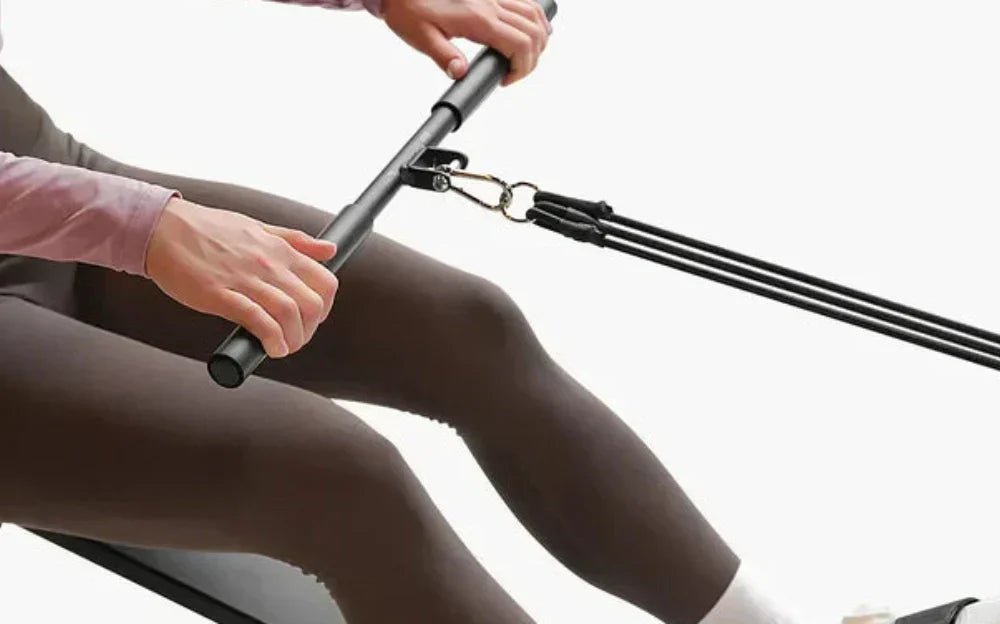As a form of cardio that engages 86% of the body’s muscles while remaining low-impact on the joints, rowing machines have become a popular workout option for many. The Tousains 3 in 1 rowing machine, in particular, features a built-in small cable crossover function and is favored by those who seek a total body workout.
However, it is worth noting that whether rowing on water or using a rowing machine, repetitive movements and improper form can lead to injuries. In this article, we will introduce common rowing injuries and how to prevent them. Let’s jump in right now!
Understand the Causes of Rowing Injuries
Rowing injuries are primarily caused by repetitive motion, poor technique, overtraining, pre-existing health issues, or insufficient warm-up and recovery. Though the rowing stroke is low-impact, it requires body coordination, especially in the lower back, shoulders, knees, and wrists. When muscles are imbalanced or movements are misaligned, strain can occur.
Most Common Rowing Injuries
Lower Back Pain
Cause: The repetitive rowing stroke can put strain on the lower back and cause pain over time. In addition, rowing posture and previous history or genetic predisposition, as well as ergometer training in 30 minutes plus sessions can cause this pain, according to Performance Health.

How to Prevent
- Maintain a neutral spine throughout the stroke.
- Strengthen the core to support spinal stability.
- Avoid slouching at the catch and overextension at the finish.
- Listen to your body and don’t make your rowing session too long.
- Consult a doctor if you have previous health issues.
Shoulder Impingement
Cause: Repeated overhead or forward arm movements can cause shoulder tendons to rub against bone, leading to inflammation and impingement. In addition, overtraining in rowing or adding too much intensity can lead to this pain.
How to Prevent
- Keep shoulders relaxed and down during strokes.
- Strengthen rotator cuff, upper back muscles, and core to help.
- Avoid excessive hunching or reaching at the catch.
- Be sure to stretch and warm up before and after rowing
Knee Pain
Cause: Rowing is a repetitive workout. Although rowing is generally gentle on the knees, excessive knee bending and rapid extension can irritate the cartilage under the kneecap, especially if tracking is misaligned.

How to Prevent:
- Avoid locking knees during extension.
- Ensure proper seat-to-footplate alignment.
- Don’t overcompress at the catch position.
- Strengthen the hip and glute muscles to support proper knee alignment.
- Use foam rollers to loosen tight quads.
Wrist Tendonitis
Cause: This is the most common wrist injury for rowers. Continuous flexion and extension of the wrists during the stroke can lead to strain and inflammation.
How to Prevent:
- Maintain a straight wrist during the drive and recovery.
- Avoid gripping the handle too tightly.
- Use ergonomic grips or padded handles if available.
Rower’s Rib
Cause: According to Physiopedia, rib stress fractures are mainly caused by muscle fatigue altering force distribution and repeated muscle-driven compression that leads to bone damage. To reduce RSI risk, Rowing Stronger suggests that you should manage training transitions carefully, avoid overlapping risk factors, prioritize recovery (sleep, nutrition, stress), and incorporate targeted strength training to improve movement coordination and force transmission.
General Tips for Injury Prevention
Warm Up and Cool Down: Stretches before and after workouts help protect muscles, joints, and prepare you for the rowing session.
Cross-Training: Mix rowing with strength training, yoga, or swimming to balance muscle groups and reduce overuse.
Listen to Your Body: While it is important to achieve your rowing goals, you should listen to your body and stop whenever it is necessary.
Proper Form: Investing time in learning the correct rowing techniques online or in physical classes can prevent most injuries.
Conclusion
It goes without saying that rowing is an effective workout. However, just as Dr. Jo Hannafin said in the Hospital for Special Surgery, “some of the injuries that rowers (athletes) get can’t be prevented... particularly the low back and rib injuries... and the goal is actually to diagnose the injury early, shut them down for a shorter period of time.”
If you are rowing for weight loss, cardiovascular health, muscle toning, etc., you can continue to enjoy the benefits of this full-body workout by being aware of the most common rowing injuries and taking steps to treat and prevent them.


